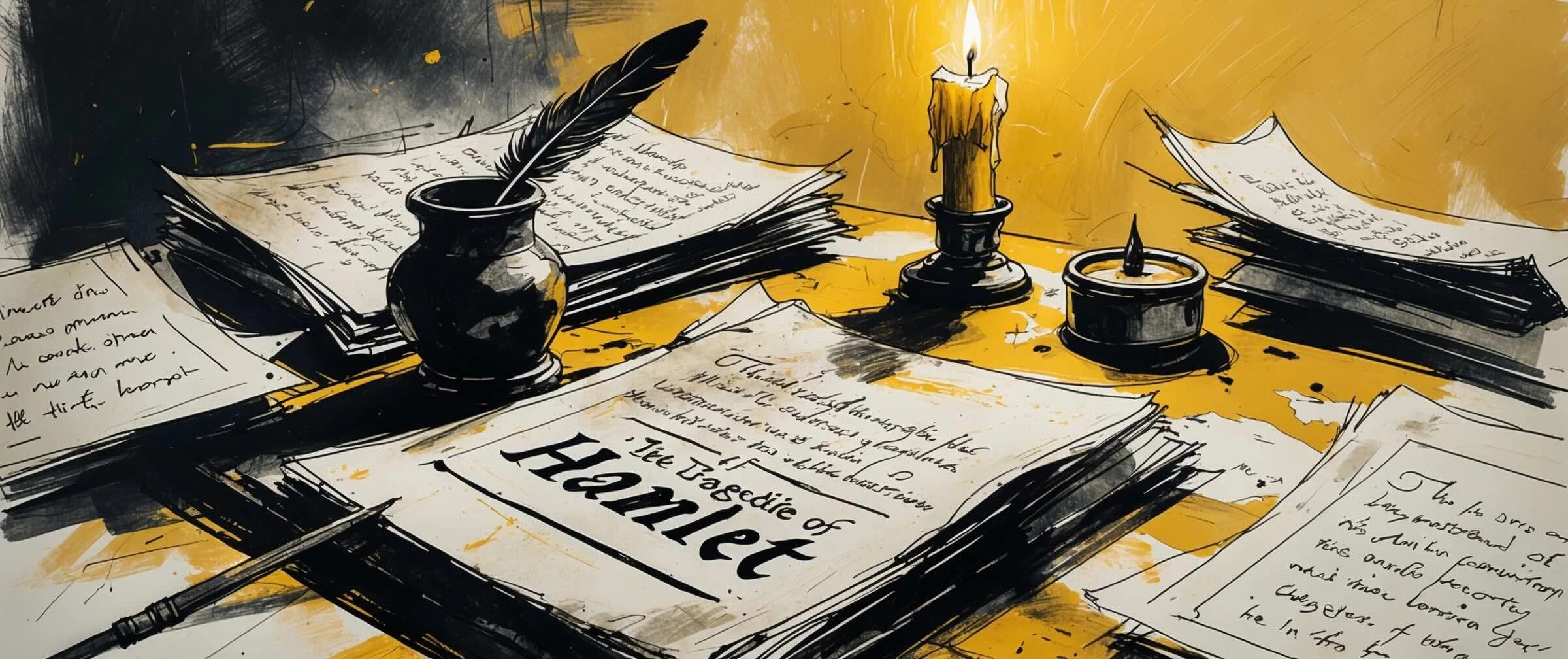Hamlet: Context & Background
Context Profile – At a Glance
Date Written: Approx. 1599–1601 (Late Elizabethan Era).
The Genre: Revenge Tragedy.
Primary Source: The Scandinavian legend of Amleth by Saxo Grammaticus.
The "Ur-Hamlet": A lost earlier play (likely by Thomas Kyd) that Shakespeare adapted.
Historical Tension: The play bridges the gap between the medieval Catholic past (Ghosts, Purgatory) and the Protestant present (Wittenberg, rejection of spirits).
Political Backdrop: Written near the end of Elizabeth I’s reign, reflecting anxieties about succession and the health of the state.
The Origins: From Legend to Stage
Shakespeare did not invent the plot of Hamlet. Like most of his plays, he adapted it from existing sources, transforming a crude revenge tale into a psychological masterpiece.
The primary source is the Scandinavian Legend of Amleth, recorded by the Danish historian Saxo Grammaticus in the 12th century. In this version, the young prince Amleth feigns madness (acting like a simpleton) to survive after his uncle kills his father. However, unlike Shakespeare’s indecisive hero, the legendary Amleth has no moral qualms; he burns down the hall, kills his uncle, and becomes King.
Scholars also believe Shakespeare was influenced by a lost play known as the "Ur-Hamlet" (likely written by Thomas Kyd, author of The Spanish Tragedy). This earlier play introduced the Ghost and the play-within-a-play structure, establishing the conventions of the Elizabethan Revenge Tragedy genre that Shakespeare would later deconstruct.
The Religious Crisis: Purgatory vs. Protestantism
To understand Hamlet, one must understand the religious turmoil of the Reformation. England had recently shifted from Catholic to Protestant, creating a deep cultural anxiety about the afterlife.
This tension is personified in The Ghost. The Ghost claims to be from Purgatory ("confined to fast in fires"), a distinctly Catholic concept where souls are purged of sin. However, Prince Hamlet studies at Wittenberg, the university where Martin Luther launched the Protestant Reformation.
Protestant doctrine rejected Purgatory, teaching that spirits were either angels from Heaven or devils from Hell sent to deceive ("The spirit that I have seen / May be the devil"). This theological clash explains Hamlet’s hesitation: he is a modern Protestant intellectual haunted by a medieval Catholic ghost. He cannot simply kill Claudius because he must first determine if the Ghost is a "spirit of health or goblin damned."
Political Anxiety: The End of an Era
Hamlet was written around 1600, during the twilight years of Queen Elizabeth I’s reign. The Queen was elderly and had no children, leaving England with no clear heir. The nation was gripped by a fear of civil war, foreign invasion, and a succession crisis.
This atmosphere of uncertainty permeates the play. Denmark is preparing for war; guards are on edge; and the question of who rules—and who should rule—is central. The "rotten" state of Denmark mirrors the anxieties of Elizabethan England, fearing that the death of the monarch would lead to chaos ("The cease of majesty / Dies not alone, but like a gulf doth draw / What's near it with it").
Renaissance Humanism
Hamlet is the first truly "modern" character in literature because he embodies Renaissance Humanism. Unlike the action-oriented heroes of the past, Hamlet is a scholar who prizes reason, philosophy, and the complexity of the human mind ("What a piece of work is a man!").
He represents the struggle between the medieval code of Blood Revenge (action, honour, violence) and the new Humanist value of Reason (conscience, law, analysis). His tragedy is that he is a man of thought forced to live in a world that demands brutal action.
Context Q&A
-
The "Ur-Hamlet" is the name scholars give to a lost play that predated Shakespeare’s Hamlet. It is believed to have been written by Thomas Kyd during the late 1580s. While no copy survives, contemporary records suggest it featured a ghost crying "Hamlet, revenge!" Shakespeare likely used this play as a skeleton, fleshing it out with his own psychological depth and philosophical complexity.
-
Shakespeare specifies that Hamlet and Horatio study at Wittenberg. This was the university where Martin Luther initiated the Protestant Reformation in 1517. By placing Hamlet there, Shakespeare identifies him as a modern, Protestant intellectual who values reason and skepticism. This puts him in direct conflict with the medieval, Catholic world of the Ghost and the corrupt court of Elsinore.
-
Written at the end of Elizabeth I’s reign, the play reflects the fear of an uncertain succession. Elizabeth had no heir, and England feared civil war or foreign invasion (represented in the play by Fortinbras of Norway). The phrase "Something is rotten in the state of Denmark" captures the mood of a nation waiting for its monarch to die, fearing that the political order is collapsing.
-
The Revenge Tragedy was a popular genre in Elizabethan theatre, influenced by the Roman playwright Seneca. Key conventions included: a secret murder, a ghost demanding vengeance, a hesitancy in the hero, real or feigned madness, and a bloody finale where most characters die. Shakespeare uses these tropes but subverts them by focusing on the hero's internal psychological struggle rather than just the external violence.
-
It is unclear what Shakespeare believed, but his audience was deeply divided. Traditional Catholics believed ghosts were souls from Purgatory asking for help (prayers or revenge). Protestants believed ghosts were demons sent by Satan to trick the living into committing sins (like murder/suicide). Shakespeare exploits this ambiguity to create tension: Hamlet’s hesitation is not just cowardice, but a valid theological fear that the Ghost is a "devil" trying to damn his soul.

